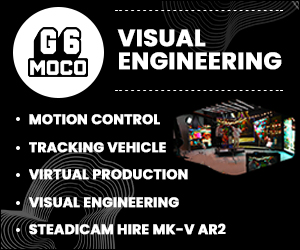Broadcast News
23/06/2010
Pre-Roll Just Got More Complicated
By Rob Leishman, Marketing Manager, Abit.
Managing the delay or pre-roll in a transmission path means an automation system has to begin playout of material slightly in advance to ensure the broadcast of all elements of the channel start on time.
The more complex, flexible and imaginative the channel image becomes the more timing issues need to be resolved and managed by the automation system. Add the up and down conversion between SD and HD into the mix and the addition of new features like split screen channel branding and pre-roll just got a lot more complicated for the average automation system.
The first part of the workflow is to get all of the programme material and branding elements transferred into the transmission environment ready for playout. A lot of automation systems rely on the media asset management system to supply material to the transmission server for playout at the correct time. This is rather like 'expecting something in the post.' Problems in transfer are invisible to the transmission environment and can not easily be rectified and what happens if you need to make a last minute change to the schedule?
For this reason, the ideal scenario is where the automation system is responsible for moving file based material from the IT domain into the transmission domain. Then, the operator in the transmission suite remains in overall control and has the tools to monitor and step-in and cancel and restart the transfer should it be too slow or if there is a fault elsewhere in a peripheral device or in the network architecture preventing delivery on time.
To achieve this, the automation system needs to be designed to prioritise the transfer of material making use of multiple FTP sessions over a broadband Ethernet. The sessions are managed by the automation system while the broadband Ethernet connects a range of equipment including transmission, archive and file based servers along with graphics play-out devices.
In the event that there is insufficient time to complete the file transfer, a device API is used to set up a TCP/IP connection allowing play-out of the file while in the background the remainder of the file is transferred.
These transfers are time dependant but the real complexity is when the timing has to take into account the device characteristics. Time delayed play-out of a channel can simply be recorded and shifted by a fixed time delay with commercial opt-outs allowing different commercial material to be played out with fixed linkage of channels. When the secondary channel needs to be reformatted to meet regulatory issues, then it becomes much more complex.
Firstly the channel needs to be reformatted automatically to meet the host country's regulations for different commercial slot timing and placement. Secondly, operational or schedule changes need to be reflected correctly in the secondary channels. Thirdly, any changes - such as moving the channel logo - that overlaps information embedded in the play-out material or changes the aspect ratio need to be addressed. It is only possible to manage the increased complexity of this workflow with complete accuracy if the automation system retains control of the movement and insertion of material.
Pre-roll traditionally was starting play-out a fixed number of frames early on a VTR so that mechanically everything was operating optimally before play-out. However, these days, play-out is much more challenging as the workflow in the transmission path is not fixed but adaptive dependant on both network performance and the material type resulting in variable delays depending on the routing. The best way to manage this added complexity is with an automation system that gives the operator one point of control.
Abit’s Present-it automation system has been developed in this way to meet the needs of the increasingly complex workflow that we see in broadcast environments today.
For more information visit: www.abit.co.uk
(BMcN)
Managing the delay or pre-roll in a transmission path means an automation system has to begin playout of material slightly in advance to ensure the broadcast of all elements of the channel start on time.
The more complex, flexible and imaginative the channel image becomes the more timing issues need to be resolved and managed by the automation system. Add the up and down conversion between SD and HD into the mix and the addition of new features like split screen channel branding and pre-roll just got a lot more complicated for the average automation system.
The first part of the workflow is to get all of the programme material and branding elements transferred into the transmission environment ready for playout. A lot of automation systems rely on the media asset management system to supply material to the transmission server for playout at the correct time. This is rather like 'expecting something in the post.' Problems in transfer are invisible to the transmission environment and can not easily be rectified and what happens if you need to make a last minute change to the schedule?
For this reason, the ideal scenario is where the automation system is responsible for moving file based material from the IT domain into the transmission domain. Then, the operator in the transmission suite remains in overall control and has the tools to monitor and step-in and cancel and restart the transfer should it be too slow or if there is a fault elsewhere in a peripheral device or in the network architecture preventing delivery on time.
To achieve this, the automation system needs to be designed to prioritise the transfer of material making use of multiple FTP sessions over a broadband Ethernet. The sessions are managed by the automation system while the broadband Ethernet connects a range of equipment including transmission, archive and file based servers along with graphics play-out devices.
In the event that there is insufficient time to complete the file transfer, a device API is used to set up a TCP/IP connection allowing play-out of the file while in the background the remainder of the file is transferred.
These transfers are time dependant but the real complexity is when the timing has to take into account the device characteristics. Time delayed play-out of a channel can simply be recorded and shifted by a fixed time delay with commercial opt-outs allowing different commercial material to be played out with fixed linkage of channels. When the secondary channel needs to be reformatted to meet regulatory issues, then it becomes much more complex.
Firstly the channel needs to be reformatted automatically to meet the host country's regulations for different commercial slot timing and placement. Secondly, operational or schedule changes need to be reflected correctly in the secondary channels. Thirdly, any changes - such as moving the channel logo - that overlaps information embedded in the play-out material or changes the aspect ratio need to be addressed. It is only possible to manage the increased complexity of this workflow with complete accuracy if the automation system retains control of the movement and insertion of material.
Pre-roll traditionally was starting play-out a fixed number of frames early on a VTR so that mechanically everything was operating optimally before play-out. However, these days, play-out is much more challenging as the workflow in the transmission path is not fixed but adaptive dependant on both network performance and the material type resulting in variable delays depending on the routing. The best way to manage this added complexity is with an automation system that gives the operator one point of control.
Abit’s Present-it automation system has been developed in this way to meet the needs of the increasingly complex workflow that we see in broadcast environments today.
For more information visit: www.abit.co.uk
(BMcN)
Top Related Stories
Click here for the latest broadcast news stories.
21/01/2005
Time Warner's NY1 expands OmniBus automation system
OmniBus Systems has announced that NY1, a 24-hour Time Warner Cable news channel covering New York City, has expanded its Columbus automation system t
Time Warner's NY1 expands OmniBus automation system
OmniBus Systems has announced that NY1, a 24-hour Time Warner Cable news channel covering New York City, has expanded its Columbus automation system t
22/04/2022
Sony's New HDC-F5500 Live System Camera To Be Used For The First Time
Sony's new HDC-F5500 live system camera will be used for the first time in Europe in a live sports broadcast scenario as part of a 4K HDR workflow bri
Sony's New HDC-F5500 Live System Camera To Be Used For The First Time
Sony's new HDC-F5500 live system camera will be used for the first time in Europe in a live sports broadcast scenario as part of a 4K HDR workflow bri
21/01/2025
Audio-Technica System 20 PRO Wireless System To Receive ISE Debut
Audio-Technica is to show a variety of its installation-oriented audio solutions at ISE 2025, including the recently-launched System 20 PRO wireless s
Audio-Technica System 20 PRO Wireless System To Receive ISE Debut
Audio-Technica is to show a variety of its installation-oriented audio solutions at ISE 2025, including the recently-launched System 20 PRO wireless s
31/01/2019
ChyronHego Pairs TRACAB Optical Tracking System And CLICK Effects Graphics Authoring System
At separate football matches in Denmark and the Netherlands, ChyronHego has introduced a solution by pairing the company's TRACAB optical tracking sys
ChyronHego Pairs TRACAB Optical Tracking System And CLICK Effects Graphics Authoring System
At separate football matches in Denmark and the Netherlands, ChyronHego has introduced a solution by pairing the company's TRACAB optical tracking sys
01/10/2014
Endemol Deploys DIVArchive CSM System And DIVAdirector MAM System
Front Porch Digital has announced that global production powerhouse Endemol has deployed a DIVArchive® CSM system and DIVAdirector® media asset manage
Endemol Deploys DIVArchive CSM System And DIVAdirector MAM System
Front Porch Digital has announced that global production powerhouse Endemol has deployed a DIVArchive® CSM system and DIVAdirector® media asset manage
15/08/2007
Cambridge Imaging System To Launch Digital TV System At IBC
Cambridge Imaging Systems, the digital archive management specialist, will launch T-Gate, a new, efficient way to manage enterprise digital TV, at IBC
Cambridge Imaging System To Launch Digital TV System At IBC
Cambridge Imaging Systems, the digital archive management specialist, will launch T-Gate, a new, efficient way to manage enterprise digital TV, at IBC
11/05/2023
Sky News Arabia Selects DAD Automation System From ENCO
Through its extensive presence across the Middle East and North Africa region, Sky News Arabia broadcasts comprehensive 24/7 regional and internationa
Sky News Arabia Selects DAD Automation System From ENCO
Through its extensive presence across the Middle East and North Africa region, Sky News Arabia broadcasts comprehensive 24/7 regional and internationa
03/03/2023
UCR Renews AEQ Mar4Suite Pro Automation System
The University of Costa Rica (UCR) is one of the five state universities of the Republic of Costa Rica, being considered one of the most prestigious a
UCR Renews AEQ Mar4Suite Pro Automation System
The University of Costa Rica (UCR) is one of the five state universities of the Republic of Costa Rica, being considered one of the most prestigious a
29/06/2016
ARTE Selects Marina System To Renew Playout Automation
Pebble Beach Systems has announced that ARTE, the European culture channel, has chosen the Marina automation system to renew its playout automation an
ARTE Selects Marina System To Renew Playout Automation
Pebble Beach Systems has announced that ARTE, the European culture channel, has chosen the Marina automation system to renew its playout automation an
08/01/2015
KPVI-TV Implements NVerzion Automation System
NVerzion has announced that KPVI-TV, the local NBC-affiliated station in Idaho for Idaho Falls and Pocatello, and owned by Frontier Broadcast, has imp
KPVI-TV Implements NVerzion Automation System
NVerzion has announced that KPVI-TV, the local NBC-affiliated station in Idaho for Idaho Falls and Pocatello, and owned by Frontier Broadcast, has imp
19/06/2014
Pebble Beach Delivers Japanese Marina Automation System To Aruji TV
Automation, content management and integrated channel providers Pebble Beach Systems has announced at BroadcastAsia that it has been awarded the contr
Pebble Beach Delivers Japanese Marina Automation System To Aruji TV
Automation, content management and integrated channel providers Pebble Beach Systems has announced at BroadcastAsia that it has been awarded the contr
15/01/2013
AIR Replaces Automation System With Radio-Assist 8.1
All India Radio (AIR), the national radio broadcaster of India and a division of Prasar Bharati group, is replacing its existing news and radio automa
AIR Replaces Automation System With Radio-Assist 8.1
All India Radio (AIR), the national radio broadcaster of India and a division of Prasar Bharati group, is replacing its existing news and radio automa
20/08/2009
Abit To Showcase Compact Automation System At IBC
Playout automation specialist, Abit, will display its new, cost effective, 'compact' automation system for the first time at IBC this year on Stand 8.
Abit To Showcase Compact Automation System At IBC
Playout automation specialist, Abit, will display its new, cost effective, 'compact' automation system for the first time at IBC this year on Stand 8.
08/07/2008
Abit To Show New Linux Based Automation System At IBC
Playout automation specialist Abit Ltd have announced that they will show the new operating system for its automation system for the first time at IBC
Abit To Show New Linux Based Automation System At IBC
Playout automation specialist Abit Ltd have announced that they will show the new operating system for its automation system for the first time at IBC
15/05/2008
TBS Played Out With Pro-Bel's Morpheus Automation System
Pro-Bel, providers of innovative automation, media management and master control solutions as well as routing, control and signal distribution systems
TBS Played Out With Pro-Bel's Morpheus Automation System
Pro-Bel, providers of innovative automation, media management and master control solutions as well as routing, control and signal distribution systems















